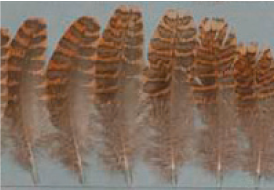







Color Reproduction
 The search for the best possible color reproduction of the feather portraits does not end here. Many tests are made by professional photographers, both with slides and negatives, using expensive camera models from Nikon and other producers, as well as several digital cameras, and a camera scanner from Leica.
The search for the best possible color reproduction of the feather portraits does not end here. Many tests are made by professional photographers, both with slides and negatives, using expensive camera models from Nikon and other producers, as well as several digital cameras, and a camera scanner from Leica.
The results of all these tests reveal difficulties with the lighting conditions:
- When a lamp in the studio is only slightly moved accidentally, a photo of the same feather portrait can suddenly look quite different from one taken previously. Stray light is another problem. In addition, the feathers stand off from their background and thereby cast shadows, while undesired light reflections often occur on dark shafts. Therefore, the option of producing photos with cameras or camera scanners is abandoned.
- By contrast, the method of using flatbed scanners does not pose the problems mentioned above. When the feathers are pressed against the glass plate of the scanner and scanned parallel to the movement of the scanner lamp, they do not cast shadows, while the scanner lamp produces repeatable lighting conditions for every single scan, without stray light. Direct scans of feathers are also sharper than photos. Therefore, the option of using flatbed scanners is pursued.
One of the top technical experts at the headquarters of Linotype, Dr. Sehran Tatari, gives private scanning lessons to Gabriel. Dr. Tatari has focused his Ph.D. on the ability of scanners to recognize fine wood structures for the identification of tree species, and is very interested in the feather project, which bears a lot of similarity to his Ph.D. project.
A decision is made to test different flatbed scanners for their ability to capture the colors and 3-dimensional structure of feathers and to compare their performances to that of the Linotype Opal. During the course of this year, all other major producers of high-end flatbed scanners besides Linotype are contacted: Epson, Agfa, Fujicolor, Umax, Microtek and Purup Eskofot. They are given samples of feather portraits to produce test scans. The most impressive scan was produced on a Lanovia C550 from Fujicolor. This is a scanner specialized for scanning 3-dimensional objects. It optimizes the focus of the lens at every point of the original for maximum sharpness. A scan of a feather portrait produced on a Lanovia C550 and printed out on Fuji photo paper looks so real that the feathers literally jump off the surface. Unfortunately, this scanner model costs more than 50,000 Euro, which is beyond the scope of the project.
A scanner model which comes close to the 3-dimensional image capturing abilities of the Lanovia C550 is the Epson GT 12000, which lies in a similar price range as the Linotype Opal. While the Linotype Opal is extraordinarily well suited for reproducing the more spectacular fluorescent colors on feathers, the Epson GT 12000 yields good results in capturing the more subtle differences in the dull brown-grey colors that predominate on the feathers of European birds. With the results of all these test scans at hand, a call is made to the company Epson to ask whether they are willing to provide a GT 12000 for the project. Ms. Mechthild Knopp from Epson kindly agrees to provide such a scanner for half a year on loan.
The test scans with different scanner models reveal another important point:
- The software used for operating a scanner is of crucial importance. Many scanners can be operated with different software packages. Each software will yield a different result, and the differences can be dramatic. Often, the software that is provided by the scanner producer itself is not the best for that scanner.
- Today, the world standard in scanner software is considered to be SilverFast. SilverFast was developed by the company LaserSoft Imaging in Kiel, Germany. The Epson GT 12000 can be operated with this excellent software, which is bundled by Epson with its own software.
The chairman of LaserSoft Imaging, Karl-Heinz Zahorsky, happens to be an old friend of Gabriel‘s parents. Gabriel gives a call to Mr. Zahorsky and describes to him the brilliant results achieved by SilverFast on the feather portraits with Epson‘s loaned GT 12000. The time to return this scanner to Epson is approaching. Mr. Zahorsky happens to have exactly the same scanner model, a GT 12000, in his office, which was given to him by Epson for development purposes. He says he will soon not need this scanner anymore, and very generously offers this scanner for the project together with his excellent software. This scanner and Mr. Zahorsky's software SilverFast will become the backbone of the project. The majority of feather portraits are scanned with it.
Mr. Zahorsky had also donated a second scanner of the same type to Peter Petersen, who works in the image processing department of Maharishi European Research University in the Netherlands. Gabriel had done his literature research in ancient architecture at this university and came to know Mr. Petersen there. For some time, both of these scanners are used for the feather project, using SilverFast on both.
 English
English Deutsch
Deutsch Français
Français Italiano
Italiano 日本語
日本語 Español
Español Português
Português Russian
Russian Chinese (Simp.)
Chinese (Simp.) Tchèque
Tchèque Polonais (seulement boutique)
Polonais (seulement boutique)